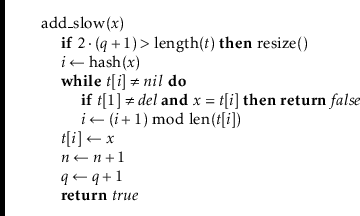Next: 6. Binary Trees Up: 5. Hash Tables Previous: 5.3 Hash Codes Contents Index
Hash tables and hash codes represent an enormous and active field of research that is just touched upon in this chapter. The online Bibliography on Hashing [10] contains nearly 2000 entries.
A variety of different hash table implementations exist. The one described in Section 5.1 is known as hashing with chaining (each array entry contains a chain (List) of elements). Hashing with chaining dates back to an internal IBM memorandum authored by H. P. Luhn and dated January 1953. This memorandum also seems to be one of the earliest references to linked lists.
An alternative to hashing with chaining is that used by open addressing schemes, where all data is stored directly in an array. These schemes include the LinearHashTable structure of Section 5.2. This idea was also proposed, independently, by a group at IBM in the 1950s. Open addressing schemes must deal with the problem of collision resolution: the case where two values hash to the same array location. Different strategies exist for collision resolution; these provide different performance guarantees and often require more sophisticated hash functions than the ones described here.
Yet another category of hash table implementations are the so-called
perfect hashing methods.
These are methods in which
![]() operations take
operations take ![]() time in the worst-case. For static data sets,
this can be accomplished by finding perfect hash functions
for
the data; these are functions that map each piece of data to a unique
array location. For data that changes over time, perfect hashing
methods include FKS two-level hash tables
[31,24]
and cuckoo hashing [55].
time in the worst-case. For static data sets,
this can be accomplished by finding perfect hash functions
for
the data; these are functions that map each piece of data to a unique
array location. For data that changes over time, perfect hashing
methods include FKS two-level hash tables
[31,24]
and cuckoo hashing [55].
The hash functions presented in this chapter are probably among the most
practical methods currently known that can be proven to work well for any
set of data. Other provably good methods date back to the pioneering work
of Carter and Wegman who introduced the notion of universal hashing
and described several hash functions for different scenarios [14].
Tabulation hashing, described in Section 5.2.3, is due to Carter
and Wegman [14], but its analysis, when applied to linear probing
(and several other hash table schemes) is due to P![]() tra
tra![]() cu and
Thorup [58].
cu and
Thorup [58].
The idea of multiplicative hashing
is very old and seems to be
part of the hashing folklore [48, Section 6.4]. However, the
idea of choosing the multiplier
![]() to be a random odd number,
and the analysis in Section 5.1.1 is due to Dietzfelbinger et al. [23]. This version of multiplicative hashing is one of the
simplest, but its collision probability of
to be a random odd number,
and the analysis in Section 5.1.1 is due to Dietzfelbinger et al. [23]. This version of multiplicative hashing is one of the
simplest, but its collision probability of
![]() is a factor of two
larger than what one could expect with a random function from
is a factor of two
larger than what one could expect with a random function from
![]() . The multiply-add hashing
method uses the function
. The multiply-add hashing
method uses the function
There are a number of methods of obtaining hash codes from fixed-length
sequences of
![]() -bit integers. One particularly fast method
[11] is the function
-bit integers. One particularly fast method
[11] is the function

The method from Section 5.3.3 of using polynomials over prime fields
to hash variable-length arrays and strings is due to Dietzfelbinger et al. [22]. Due to its use of the ![]() operator which relies
on a costly machine instruction, it is, unfortunately, not very fast.
Some variants of this method choose the prime
operator which relies
on a costly machine instruction, it is, unfortunately, not very fast.
Some variants of this method choose the prime
![]() to be one of the form
to be one of the form
![]() , in which case the
, in which case the ![]() operator can be replaced with
addition (
operator can be replaced with
addition (![]() ) and bitwise-and (
) and bitwise-and (![]() ) operations [47, Section 3.6].
Another option is to apply one of the fast methods for fixed-length
strings to blocks of length
) operations [47, Section 3.6].
Another option is to apply one of the fast methods for fixed-length
strings to blocks of length ![]() for some constant
for some constant ![]() and then apply
the prime field method to the resulting sequence of
and then apply
the prime field method to the resulting sequence of
![]() hash codes.
hash codes.

Depending on how good the implementation is, you may be able to do this just by inspecting the code for the implementation, or you may have to write some code that does trial insertions and searches, timing how long it takes to add and find particular values. (This can be, and has been, used to launch denial of service attacks on web servers [17].)